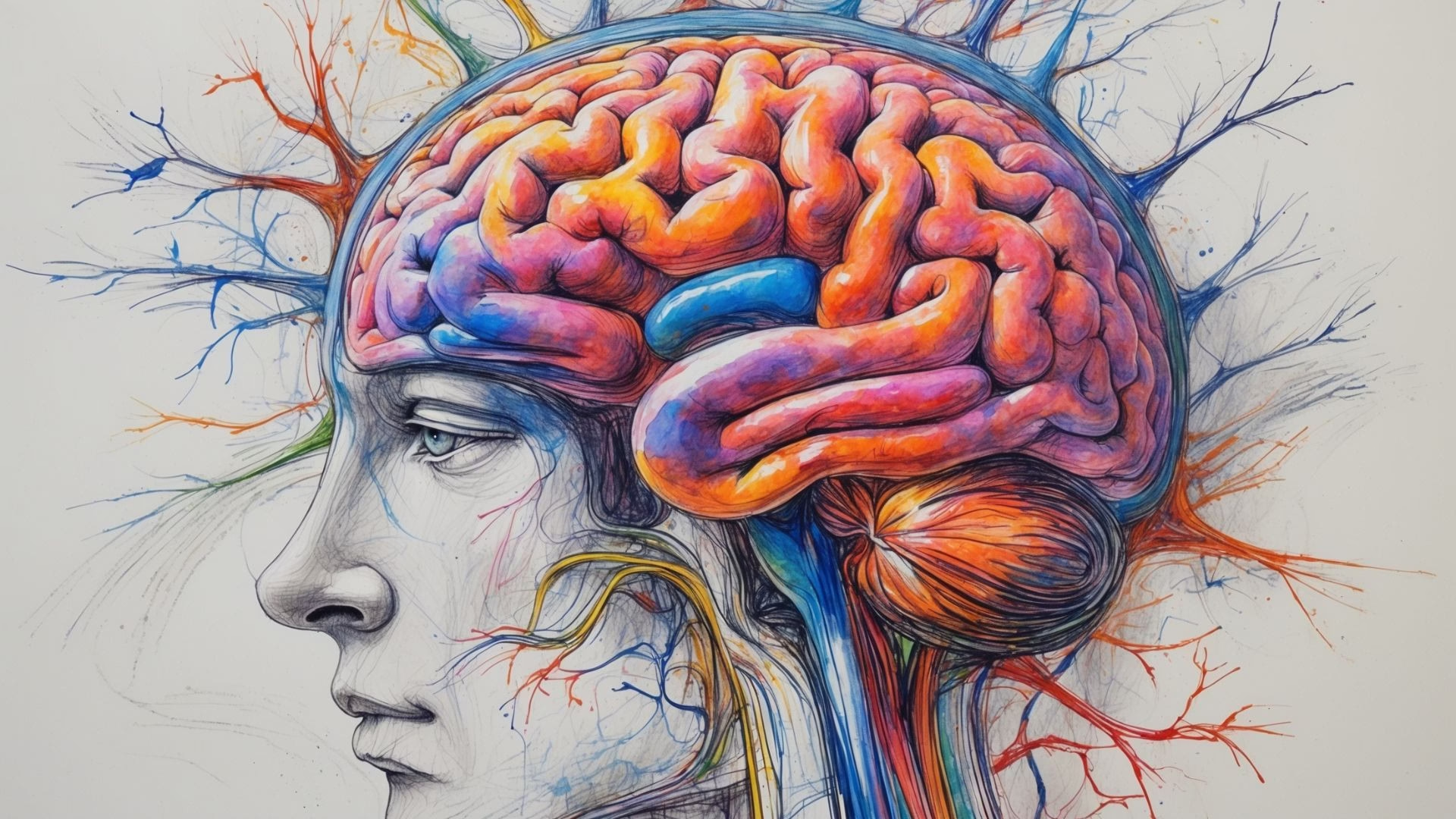- The Deep Dive
- The Universe Between Your Ears
- Q1: Just how complex is the brain? What’s it made of?
- Q2: The Big One: Is it true we only use 10% of our brain?
- Q3: What’s the deal with “left brain” vs. “right brain” personalities?
- Q4: How do brain cells (neurons) actually talk to each other?
- Q5: Can the brain change over time? What is neuroplasticity?
- Q6: How does memory work? Is it like a computer file?
- Q7: Why is sleep so important for the brain?
- Q8: Can scientists read my mind with brain scans?
- Q9: What causes brain disorders like Alzheimer’s or Parkinson’s?
- Q10: What are the best ways to keep my brain healthy?
- The Journey Continues
- Reading Comprehension Quiz
- Let’s Talk | Listening
- Listening Comprehension Quiz
- Let’s Learn Vocabulary in Context
- Vocabulary Quiz
- Let’s Discuss & Write
- Learn with AI
- Let’s Play & Learn
The Deep Dive
The Universe Between Your Ears
Welcome, curious minds, to an exploration of the most complex, sophisticated, and downright mysterious object we know of: the human brain. This intricate organ, weighing about three pounds and resembling a particularly wrinkly walnut, is the command center for your entire existence. It orchestrates your thoughts, fuels your emotions, stores your memories, animates your movements, and constructs your reality. It’s the seat of consciousness itself – the very thing that allows you to read and ponder these words. Neuroscience, the scientific study of the nervous system (and especially the brain), is a field buzzing with discoveries, constantly shedding new light on how this biological marvel works. Yet, many questions and quite a few myths persist. Let’s tackle some of the most frequently asked questions about your brain and the science that seeks to understand it.
Q1: Just how complex is the brain? What’s it made of?
Prepare to be staggered. Your brain contains roughly 86 billion specialized cells called neurons. These are the primary communicators, the information messengers of the nervous system. But they aren’t alone! They are vastly outnumbered (perhaps by as much as ten to one, though estimates vary) by glial cells, which were once thought to be mere support structures but are now known to play active roles in brain function, including modulating communication, providing nutrients, cleaning up waste, and forming insulation.
These cells are organized into different structures. You often hear about “grey matter” and “white matter.” Grey matter primarily consists of neuron cell bodies, dendrites (receiving branches), and glial cells – it’s where the processing happens. White matter is mostly made up of long neuronal projections called axons, wrapped in a fatty insulating sheath called myelin, which act like the brain’s wiring, transmitting signals between different grey matter regions. All this complexity is packed into a relatively small space, powered by about 20% of your body’s total energy consumption, despite being only about 2% of your body weight!
Q2: The Big One: Is it true we only use 10% of our brain?
Let’s put this popular myth to rest definitively: No, it is absolutely not true. This is perhaps one of the most persistent and pervasive neuromyths out there, perpetuated by self-help gurus, science fiction films, and perhaps wishful thinking. Brain imaging techniques like fMRI (functional Magnetic Resonance Imaging) and PET (Positron Emission Tomography) clearly show that large areas of the brain, often the entire brain, exhibit activity even during simple tasks or rest.
While it’s true that you don’t use all of your brain all at once at maximum capacity (that would likely result in a massive seizure!), virtually every part of the brain has a known function and is active at various times. Different tasks engage different neural networks more intensely, but there are no vast, dormant areas waiting to be unlocked. Evolution is incredibly efficient; it simply wouldn’t have favoured the development and energy cost of such a large brain if 90% of it were useless ballast. So, congratulations – you’re already using your whole brain! The key is learning to use it effectively.
Q3: What’s the deal with “left brain” vs. “right brain” personalities?
This is another popular simplification that stretches a kernel of truth into a misleading dichotomy. The brain is divided into two hemispheres, left and right, connected by a massive bundle of nerve fibers called the corpus callosum. There is scientific evidence for hemispheric lateralization, meaning that some cognitive functions tend to be processed more predominantly in one hemisphere than the other.
For most right-handed people (and many left-handed people), language processing (speaking, writing, understanding language) is heavily dominant in the left hemisphere. Conversely, tasks involving spatial reasoning, facial recognition, and processing certain emotional cues often show more activity in the right hemisphere.
However – and this is crucial – this does not mean individuals are “left-brained” (logical, analytical) or “right-brained” (creative, intuitive). These personality labels are pure pop psychology. In reality, complex tasks like problem-solving, appreciating music, or engaging in creative pursuits require constant communication and collaboration between both hemispheres via the corpus callosum. Healthy brain function relies on the integrated activity of the entire brain, not just one dominant side. You are not governed by one half; you are gloriously whole-brained!
Q4: How do brain cells (neurons) actually talk to each other?
It’s an astonishing electrochemical process. Imagine a microscopic relay race. When a neuron “fires,” it sends an electrical impulse, called an action potential, racing down its long projection, the axon. This signal travels incredibly fast, thanks in part to the insulating myelin sheath mentioned earlier.
When the electrical signal reaches the end of the axon (the axon terminal), it encounters a tiny gap called a synapse, which separates it from the next neuron’s receiving branches (dendrites). The electrical signal can’t jump this gap. Instead, it triggers the release of chemical messengers called neurotransmitters (like dopamine, serotonin, or acetylcholine) into the synapse.
These neurotransmitter molecules drift across the tiny synaptic gap and bind to specific receptor sites on the dendrite of the receiving neuron, like a key fitting into a lock. This binding action then initiates a response in the receiving neuron – it might excite it (making it more likely to fire its own action potential) or inhibit it (making it less likely). Billions of neurons are performing this intricate synaptic ballet trillions of times every second to allow you to think, feel, and act.
Q5: Can the brain change over time? What is neuroplasticity?
Absolutely! One of the most revolutionary discoveries in modern neuroscience is the concept of neuroplasticity. This refers to the brain’s remarkable ability to change its structure and function in response to experience, learning, or injury throughout your entire life. It’s not a fixed, static organ once you reach adulthood.
Every time you learn a new skill (like playing an instrument or speaking a language), practice a task, or form a new memory, you are physically changing your brain. Neurons can form new connections (synapses), strengthen existing ones, or weaken connections that are no longer needed. This rewiring process is fundamental to learning and memory. Neuroplasticity is also crucial for recovery after brain injury, such as a stroke, where healthy brain areas can sometimes take over functions previously performed by damaged regions. It highlights that your brain is a dynamic, adaptable organ, constantly reshaping itself based on how you use it.
Q6: How does memory work? Is it like a computer file?
If only it were that simple! Memory isn’t stored in a single location like a file on a hard drive. It’s a complex, distributed process involving multiple brain regions working in concert.
Forming new declarative memories (memories of facts and events) heavily involves a sea-horse shaped structure deep in the brain called the hippocampus. It acts like a temporary hub or index, consolidating new information before it’s gradually transferred for more permanent storage in various areas of the cortex (the brain’s outer layer). Emotional aspects of memories are often processed and stored with the help of the amygdala, an almond-shaped structure involved in emotions like fear.
There are different types of memory, too: short-term (or working) memory holds information briefly; long-term memory stores it more permanently; procedural memory involves skills and habits (like riding a bike); episodic memory is for personal events; semantic memory is for general facts. How these networks encode, store, and retrieve information is incredibly complex and still a major focus of research.
Q7: Why is sleep so important for the brain?
Sleep isn’t just downtime; it’s essential maintenance time for your brain. While you sleep, your brain remains surprisingly active, cycling through different stages (REM – Rapid Eye Movement, and non-REM sleep). Several critical processes occur:
- Memory Consolidation: Sleep plays a vital role in strengthening memories formed during the day, transferring them from the hippocampus to the cortex for long-term storage.
- Waste Clearance: During sleep, a system called the glymphatic system becomes more active, flushing out metabolic waste products that accumulate in the brain during waking hours, including potentially harmful proteins like amyloid-beta, linked to Alzheimer’s disease.
- Brain Development & Plasticity: Sleep is crucial for brain development in infants and children and supports neuroplasticity processes throughout life.
- Emotional Regulation: Getting enough sleep helps regulate mood and emotional responses. Sleep deprivation often leads to increased irritability and emotional volatility.
Skipping sleep essentially means skipping your brain’s nightly cleaning and organizing crew.
Q8: Can scientists read my mind with brain scans?
While neuroscience technology is impressive, the idea of literal mind-reading remains firmly in the realm of science fiction for now. Techniques like fMRI allow researchers to see which brain areas become more active (by tracking blood flow changes) when a person performs a task or experiences an emotion. EEG (electroencephalography) measures electrical activity via scalp electrodes.
Scientists can use these tools to find correlations – patterns of activity associated with seeing faces, feeling fear, making decisions, or even dreaming. In controlled settings, they might even predict with some accuracy whether you’re looking at a picture of a house or a face based on your brain activity. However, this is far from deciphering complex, subjective thoughts or intentions. Brain activity is incredibly complex and variable between individuals. Current technology provides blurry snapshots or indirect measures, not a direct window into your inner monologue.
Q9: What causes brain disorders like Alzheimer’s or Parkinson’s?
Neurological and psychiatric disorders are complex and arise from a variety of factors, often involving a combination of genetics, environment, and lifestyle. Here are hugely simplified examples:
- Alzheimer’s Disease: Characterized by the progressive build-up of abnormal proteins (amyloid plaques and tau tangles) that disrupt neuron function and lead to cell death, particularly affecting memory and cognitive abilities.
- Parkinson’s Disease: Primarily results from the death of neurons that produce the neurotransmitter dopamine in a specific brain region controlling movement, leading to tremors, rigidity, and difficulty with coordination.
- Stroke: Occurs when blood flow to a part of the brain is interrupted (either by a blockage or a bleed), causing brain cells to die due to lack of oxygen and nutrients.
- Depression & Anxiety Disorders: These are complex mood disorders involving dysregulation in brain circuits and neurotransmitter systems (like serotonin, norepinephrine, and dopamine) that regulate mood, fear, and stress responses.
Research is constantly uncovering more about the intricate mechanisms underlying these conditions.
Q10: What are the best ways to keep my brain healthy?
The good news is that many lifestyle factors that benefit your overall physical health also significantly benefit your brain health! Key recommendations include:
- Physical Exercise: Regular aerobic exercise increases blood flow to the brain, promotes the growth of new neurons (especially in the hippocampus), and reduces the risk of cognitive decline.
- Healthy Diet: Diets rich in fruits, vegetables, whole grains, lean proteins, and healthy fats (like omega-3 fatty acids found in fish) support brain function. Limiting processed foods and sugar is also beneficial.
- Mental Stimulation: Keep your brain active! Engage in learning new things, reading, puzzles, playing musical instruments, or any activity that challenges you cognitively. Novelty and challenge encourage neuroplasticity.
- Quality Sleep: Prioritize getting enough restorative sleep (as discussed above). Aim for 7-9 hours for most adults.
- Social Connection: Maintaining strong social ties and engaging in social activities is linked to better cognitive health and reduced dementia risk.
- Stress Management: Chronic stress can harm the brain. Techniques like mindfulness, meditation, yoga, or spending time in nature can help manage stress levels.
- Avoid Toxins: Limit alcohol consumption and avoid smoking and illicit drug use, all of which can damage brain cells.
The Journey Continues
The human brain remains one of science’s greatest frontiers. While neuroscience has made incredible strides, uncovering many secrets of how we think, feel, learn, and remember, vast territories remain unexplored. Every answer seems to generate new questions. What is the precise nature of consciousness? How can we effectively treat debilitating brain disorders? How can we optimize brain function throughout our lifespan? Embracing the complexity and the ongoing quest for knowledge is part of the wonder. Your brain is an ever-changing marvel – keep it curious, keep it active, and keep asking questions!
Reading Comprehension Quiz
Let’s Talk | Listening
Listening Transcript: Please do not read the transcript before you listen and take the quiz.
Wow, okay, let’s just take a breath after all that brain talk! Seriously, how incredible is that squishy thing inside our heads? Reading through those FAQs, I mean, 86 billion neurons, trillions of connections… it just boggles the mind, doesn’t it? And the fact that it’s constantly changing – that whole neuroplasticity thing – is both amazing and slightly terrifying!
Think about it: the idea that everything you learn, every skill you practice, even just thinking about something differently, physically rewires your brain. It’s not just some abstract concept; it’s happening right now as you process this! That puts a whole different spin on learning, doesn’t it? It makes you realize that ‘getting stuck in your ways’ isn’t necessarily a fixed state. We have this incredible capacity to adapt and change throughout our lives. When I learned to play a few chords on the guitar (badly, I might add!), I was literally forging new pathways in my brain. How cool is that?
But it also makes me wonder… if my brain is constantly changing, who am ‘I’? Am I the same ‘me’ I was five years ago? If my memories shape me, but memory itself is a reconstructive process, not a perfect recording (as neuroscience tells us), then how stable is my sense of self? It gets pretty philosophical pretty quickly!
And what about those myths? The 10% brain myth is hilarious, isn’t it? Imagine if it were true – we’d all be bumping into things, unable to function! It’s funny how these things stick, maybe because they offer a simple, hopeful narrative – “You have untapped potential!” The left-brain/right-brain thing is similar. People love simple categories, labeling themselves ‘logical’ or ‘creative’. But the reality – that both sides work together in a complex dance – is actually much more interesting, I think. It shows that logic needs creativity and creativity benefits from structure. We’re not one or the other; we’re both.
Then there’s the stuff that sounds like science fiction but is edging closer to reality. Brain scans can’t read your specific thoughts, thankfully – can you imagine the privacy implications? But they can reveal patterns linked to certain states. Where does that lead? Could future scans detect predispositions to certain mental health conditions? Could they be used in courtrooms? Could they be used to tailor advertising directly to your brain’s responses? These aren’t just technical questions; they are deeply ethical ones we need to start thinking about now. How do we harness the power of neuroscience responsibly?
It also makes me think about brain health. We often focus on physical health – diet, exercise for our bodies. But consciously doing things for our brain feels equally important. Challenging myself to learn something new, making sure I actually get enough sleep instead of scrolling endlessly, managing stress… these aren’t just ‘nice-to-haves’; they are ways of actively maintaining the hardware that runs our entire lives. I know when I pull an all-nighter, my brain feels like mush the next day – that waste clearance system the article mentioned clearly didn’t get its job done!
But even with all these incredible discoveries, what strikes me most is how much we still don’t know. How does this intricate network of firing neurons give rise to subjective experience – the feeling of seeing red, the taste of chocolate, the emotion of love? That’s the so-called “hard problem” of consciousness, and it remains one of the biggest mysteries in science.
It’s humbling, really. We have this universe inside our heads, capable of contemplating the actual universe outside. It’s capable of understanding complex mathematics, composing symphonies, feeling empathy… and yet, it still struggles to fully understand itself. What questions does all this raise for you? Does knowing a bit more about how your brain works change how you think about yourself or how you approach your day? It definitely gives me a newfound appreciation for the quiet miracle happening behind my eyes right now.
Listening Comprehension Quiz
Let’s Learn Vocabulary in Context
Hey again! Thinking about the brain involves some pretty specific and fascinating vocabulary. We tossed around some terms in the FAQ article that are central to understanding neuroscience. Let’s unpack a few of them so you can grasp them better and maybe even use them yourself – because talking about the brain is, well, brainy!
Let’s start with the star player: the neuron. A neuron is a specialized cell that transmits nerve impulses; it’s a nerve cell. These are the fundamental units of the brain and nervous system, responsible for receiving sensory input, sending motor commands, and transforming and relaying the electrical signals at every step in between. We learned the brain has about 86 billion of them! Think of them as the individual messengers or processors in the brain’s vast communication network. So, you could say, “Learning a new language actually causes physical changes in the connections between neurons.”
Neurons communicate at junctions called synapses. A synapse is the tiny gap across which a nerve impulse passes from one neuron to another. When an electrical signal reaches the end of one neuron, it triggers the release of chemicals across this gap to affect the next neuron. It’s the crucial point of information transfer. Imagine trillions of these microscopic meeting points firing constantly. You could use it like this: “Understanding how synapses strengthen or weaken is key to understanding learning and memory.” Or more metaphorically, perhaps, “There seemed to be a synapse failure in their communication; the message just wasn’t getting across.”
The chemical messengers released at the synapse are called neurotransmitters. These are the brain’s chemical couriers. Examples include dopamine (involved in reward and movement), serotonin (mood), acetylcholine (muscle control, memory), and many others. They cross the synapse and bind to the next neuron, influencing whether it fires or not. So, imbalances in neurotransmitters are linked to various conditions, like Parkinson’s (low dopamine) or depression (often involving serotonin). You might hear someone say, “Exercise is known to boost levels of mood-enhancing neurotransmitters like endorphins.”
One of the most exciting concepts we discussed is neuroplasticity. As we covered, this is the brain’s amazing ability to reorganize itself by forming new neural connections throughout life. It means your brain isn’t fixed; it can adapt and change based on your experiences. Learning, memory formation, and recovery from brain injury all depend on neuroplasticity. It’s empowering! You could say, “The concept of neuroplasticity shows that it’s never too late to learn new skills,” or “Physical therapy after a stroke aims to harness neuroplasticity to regain function.”
We often talk about brain functions related to thinking, knowing, remembering, judging, and problem-solving. The umbrella term for these mental processes is cognitive. Cognitive functions are the high-level mental processes that allow us to perceive, think, reason, remember, and learn. So, cognitive decline refers to a decrease in these abilities, often seen in ageing or dementia. Cognitive psychology studies these processes. You might read about “cognitive enhancers” (substances claimed to improve mental performance) or talk about “cognitive biases” (systematic patterns of deviation from norm or rationality in judgment). When a task requires serious thought, you could say it places high “cognitive demands” on you.
The brain is famously divided into two hemispheres, left and right. A hemisphere is simply half of a sphere, and in brain terms, it refers to one of the two halves of the cerebrum (the main, large part of the brain). As we discussed, while they work together, certain functions tend to be more dominant in one hemisphere or the other (lateralization). You wouldn’t typically call a person a hemisphere, but you’d refer to brain anatomy or function this way: “Language processing primarily occurs in the left hemisphere for most people,” or “The two hemispheres communicate via the corpus callosum.”
The wrinkled outer layer of the cerebrum is the cortex (specifically, the cerebral cortex). Cortex means “bark” in Latin, which is quite descriptive! This layer is where most of the complex cognitive processing happens – thinking, language, consciousness, memory storage, sensory perception. It’s highly folded to maximize its surface area within the skull (more surface area = more processing power!). So, scientists might talk about activity in the prefrontal cortex (involved in decision-making) or the visual cortex (processing sight).
Deep inside the brain, we mentioned the hippocampus. This sea-horse shaped structure (its name means “sea horse” in Greek) is located in the temporal lobe and plays a critical role in learning and memory, particularly in forming new declarative memories (facts and events) and spatial navigation. Damage to the hippocampus can result in severe difficulty forming new long-term memories. So, “The hippocampus is essential for consolidating short-term memories into long-term ones.”
Another important structure, located near the hippocampus, is the amygdala. This almond-shaped structure (amygdala means “almond” in Greek) is a key player in processing emotions, especially fear and aggression. It helps link emotions to memories and influences our fight-or-flight response. An overactive amygdala might be involved in anxiety disorders. You could say, “The amygdala quickly processes potential threats in the environment,” or “Emotional memories are often particularly vivid due to the involvement of the amygdala.”
Finally, let’s touch on myelin. This is the fatty, insulating substance that surrounds the axons (the long projections) of many neurons. Think of it like the plastic insulation around an electrical wire. Myelin allows nerve impulses to travel much more quickly and efficiently down the axon. The “white matter” of the brain appears white precisely because of the high lipid content of myelin. Diseases like multiple sclerosis involve damage to the myelin sheath, disrupting nerve signal transmission. So, “The myelination of axons is crucial for rapid communication within the nervous system.”
Phew! Neuron, synapse, neurotransmitter, neuroplasticity, cognitive, hemisphere, cortex, hippocampus, amygdala, myelin. Quite the toolkit of terms! Getting familiar with them really helps unlock a deeper understanding of how that amazing universe between your ears actually works.
Vocabulary Quiz
Let’s Discuss & Write
Let’s Discuss
- How does learning about neuroplasticity change the way you think about your own potential for learning, changing habits, or recovering from setbacks?
- Before reading this, did you believe the “10% brain usage” myth or the strict “left-brain/right-brain personality” idea? Why do you think these myths are so popular and persistent?
- Neuroscience is advancing rapidly. What potential future application excites you the most (e.g., better treatments for disorders, enhanced learning)? What potential application worries you the most, perhaps ethically?
- The article listed several ways to keep the brain healthy (exercise, diet, sleep, etc.). Which of these do you actively incorporate into your life? Are there any you find particularly challenging?
- Neuroscience explores the biological basis of thought, emotion, and consciousness. Does learning about the physical mechanisms of the brain affect your understanding or appreciation of these subjective experiences? How so?
Let’s Write
Writing Prompt:
Choose ONE of the following options:
- Option A: Reflect on the concept of neuroplasticity. Write about a time you learned a new skill, changed a significant habit, or adapted to a new situation. How might the idea of your brain physically changing during that process alter your perspective on the experience? Discuss how understanding neuroplasticity might influence your approach to future learning or personal development goals. (Around 300-400 words
- Option B: Choose one specific area of neuroscience application that interests or concerns you (e.g., brain imaging in law, cognitive enhancement drugs, treatments for a specific neurological disorder, brain-computer interfaces). Do a little extra research and write a short piece explaining what it is, its potential benefits, and any associated ethical questions or limitations. (Around 300-400 words
Directions & Tips:
- Introduction: Clearly state your chosen topic (your reflection on neuroplasticity or the specific neuroscience application). Briefly set the context.
- Sample phrase (Option A): “The discovery of neuroplasticity offers a powerful lens through which to view personal growth, including my own experience learning…”
- Sample phrase (Option B): “Neuroscience is rapidly moving beyond the lab, with applications like [Chosen Application] raising both excitement and important questions.”
- Body Paragraphs:
- (Option A): Describe your chosen experience (learning/changing). Reflect on how knowing your brain was physically adapting might change how you felt then or feel now. Discuss specific ways this understanding might impact future goals (e.g., more patience, different strategies, more confidence).
- (Option B): Explain the application – what is the technology or treatment? What is it supposed to do? Describe its potential benefits (e.g., solving crimes, improving quality of life, restoring function). Discuss the limitations, risks, or ethical concerns associated with it.
- Sample phrase: “Thinking back, understanding neuroplasticity might have…”
- Sample phrase: “This technology works by…” / “The potential benefits include…”
- Sample phrase: “However, significant concerns remain regarding…” / “Limitations include…”
- Conclusion: Summarize your main reflection (Option A) or the key balance of potential and challenges for the application (Option B). Offer a final thought on the implications.
- Sample phrase: “Ultimately, embracing the brain’s capacity for change encourages…”
- Sample phrase: “As [Chosen Application] develops, careful consideration of… will be crucial.”
Remember: Use clear language. If discussing personal experience (Option A), be reflective. If discussing an application (Option B), aim for a balanced overview. Try incorporating relevant vocabulary (like neuroplasticity, cognitive, neuron, ethical, potential, limitations) naturally.
Learn with AI
Disclaimer:
Because we believe in the importance of using AI and all other technological advances in our learning journey, we have decided to add a section called Learn with AI to add yet another perspective to our learning and see if we can learn a thing or two from AI. We mainly use Open AI, but sometimes we try other models as well. We asked AI to read what we said so far about this topic and tell us, as an expert, about other things or perspectives we might have missed and this is what we got in response.
Hello! It’s fascinating to see so much interest in the brain. The FAQ covered many key areas excellently. As someone working in the field, I can perhaps add a bit more nuance to a few points and touch on things often missed in popular accounts.
Firstly, while neurons are indeed the stars of the show, we really shouldn’t underestimate glial cells. The article rightly mentioned they outnumber neurons, but their roles are far more active than just ‘support’. Astrocytes, for example, regulate blood flow, help form and prune synapses, and control the chemical environment around neurons. Microglia act as the brain’s immune cells, cleaning up debris and fighting infection, but they also play roles in synaptic plasticity. Oligodendrocytes (and Schwann cells outside the brain/spinal cord) produce that vital myelin insulation. Dysfunction in glial cells is increasingly implicated in various neurological and psychiatric disorders. They are critical, active partners in brain function.
Secondly, when we talk about neurotransmitters, it’s easy to think of them having one single function, like dopamine equals pleasure or serotonin equals happiness. This is a massive oversimplification. Most neurotransmitters are involved in multiple brain circuits and have diverse effects depending on where they are released and which specific type of receptor they bind to (often, there are many receptor subtypes for a single neurotransmitter). For example, dopamine is crucial for movement control (as seen in Parkinson’s) and motivation/reward, but also involved in attention and executive functions. Furthermore, the brain relies on a delicate balance between excitatory neurotransmitters (like glutamate, the main ‘go’ signal) and inhibitory ones (like GABA, the main ‘stop’ signal). Disruptions in this balance are key to conditions like epilepsy.
Thirdly, while mentioning key structures like the hippocampus and amygdala is important, it’s vital to emphasize the network perspective. No single brain region works in isolation. Cognitive functions, emotions, and behaviours arise from the coordinated activity of large-scale neural networks distributed across multiple brain areas. Memory, for instance, involves the hippocampus interacting constantly with the prefrontal cortex, amygdala, parietal cortex, and more. Neuroscience is increasingly focused on understanding this network connectivity (the “connectome”) and how patterns of activity within and between networks give rise to function and dysfunction.
Regarding brain imaging limitations, the article correctly stated current tech can’t read minds. It’s worth adding why. fMRI measures blood flow changes, which is an indirect measure of neural activity and relatively slow (seconds). EEG measures electrical activity directly but has poor spatial resolution (it’s hard to pinpoint exactly where the signal originates). Furthermore, every individual’s brain is slightly different anatomically and functionally. Averaging data across people can find general patterns, but interpreting a single scan from one person in detail remains challenging outside specific clinical contexts.
Finally, let’s not forget the cerebellum! Often overlooked, this structure at the back of the brain (its name means “little brain”) contains more neurons than the rest of the brain combined! While traditionally known for coordinating movement, balance, and posture, we now know it’s also involved in some cognitive functions, like learning, language, and emotional regulation. It’s another example of how interconnected and complex brain functions truly are.
Neuroscience is an incredibly exciting field precisely because there’s still so much to discover. We’re constantly refining our understanding of this intricate organ, moving from identifying specific parts to understanding their dynamic interactions within complex networks.










0 Comments